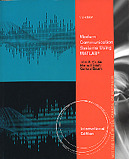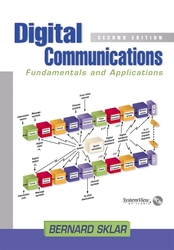Contemporary Communication Systems (IE-Paperack)
暫譯: 當代通信系統 (IE-Paperack)
Mohammed Farooque Mesiya
- 出版商: McGraw-Hill Education
- 出版日期: 2012-04-01
- 售價: $1,200
- 貴賓價: 9.8 折 $1,176
- 語言: 英文
- 頁數: 896
- 裝訂: Paperback
- ISBN: 0071086617
- ISBN-13: 9780071086615
-
相關分類:
通訊系統 Communication-systems
下單後立即進貨 (約5~7天)
買這商品的人也買了...
-
 資料庫理論與實務 SQL Server 2008
資料庫理論與實務 SQL Server 2008$580$522 -
 離散時間訊號處理 (Discrete-Time Signal Processing, 3/e)
離散時間訊號處理 (Discrete-Time Signal Processing, 3/e)$800$760 -
 Microelectronics, 2/e (IE-Paperback)
Microelectronics, 2/e (IE-Paperback)$1,560$1,529 -
 詳盡解說! App Inventor 2 Android App 範例教本 增訂第2版
詳盡解說! App Inventor 2 Android App 範例教本 增訂第2版$450$383 -
 資料科學的商業運用 (Data science for business)
資料科學的商業運用 (Data science for business)$680$537 -
Essential Scrum:敏捷開發經典 (中文版) (Essential Scrum: A Practical Guide to the Most Popular Agile Process)
$680$530 -
 建構微服務|設計細微化的系統 (Building Microservices)
建構微服務|設計細微化的系統 (Building Microservices)$580$458 -
 大數據分析 Excel Power BI 全方位應用
大數據分析 Excel Power BI 全方位應用$500$395 -
 iOS 10 App 程式設計實力超進化實戰攻略 : 知名 iOS教學部落格 AppCoda 作家親授實作關鍵技巧讓你不NG
iOS 10 App 程式設計實力超進化實戰攻略 : 知名 iOS教學部落格 AppCoda 作家親授實作關鍵技巧讓你不NG$720$562 -
 Android 程式設計入門、應用到精通, 4/e (使用Android Studio 2.X開發,涵蓋Android 7.X和Android Wear)
Android 程式設計入門、應用到精通, 4/e (使用Android Studio 2.X開發,涵蓋Android 7.X和Android Wear)$580$458 -
 前端&行動網頁設計速成班-Bootstrap 4 + CSS3 + HTML5 + JavaScript
前端&行動網頁設計速成班-Bootstrap 4 + CSS3 + HTML5 + JavaScript$520$411 -
深度學習快速入門 — 使用 TensorFlow (Getting started with TensorFlow)
$360$281 -
 Effective SQL 中文版 | 寫出良好 SQL 的 61個具體做法 (Effective SQL : 61 Specific Ways to Write Better SQL)
Effective SQL 中文版 | 寫出良好 SQL 的 61個具體做法 (Effective SQL : 61 Specific Ways to Write Better SQL)$450$356 -
 TensorFlow + Keras 深度學習人工智慧實務應用
TensorFlow + Keras 深度學習人工智慧實務應用$590$460 -
 高品質微服務|建構跨工程組織的標準化系統 (Production-Ready Microservices: Building Standardized Systems Across an Engineering Organization)
高品質微服務|建構跨工程組織的標準化系統 (Production-Ready Microservices: Building Standardized Systems Across an Engineering Organization)$450$356 -
 實戰 TensorFlow|Google 深度學習系統
實戰 TensorFlow|Google 深度學習系統$480$379 -
 實戰 Google 深度學習技術:使用 TensorFlow
實戰 Google 深度學習技術:使用 TensorFlow$520$411 -
 Deep Learning|用 Python 進行深度學習的基礎理論實作
Deep Learning|用 Python 進行深度學習的基礎理論實作$580$458 -
 $177Java 多線程編程實戰指南 (設計模式篇)
$177Java 多線程編程實戰指南 (設計模式篇) -
 .NET 設計模式
.NET 設計模式$480$379 -
 R語言:期貨演算法交易實務120個關鍵技巧詳解
R語言:期貨演算法交易實務120個關鍵技巧詳解$500$390 -
 SQL Server 與 R 開發實戰講堂
SQL Server 與 R 開發實戰講堂$680$537 -
 R 資料科學 (R for Data Science)
R 資料科學 (R for Data Science)$780$616 -
 OpenCV 範例解析
OpenCV 範例解析$450$356 -
 用 Python 開發經典遊戲 (Python Game Programming By Example)
用 Python 開發經典遊戲 (Python Game Programming By Example)$420$328
商品描述
<內容簡介>
•Simple, step-by-step presentation in sufficient detail to allow students to master the fundamental concepts in communication systems.
•The use of Simulink' as a key pedagogical tool to help students develop appreciation of theoretical models in the design and analysis of communication systems.
•Numerous examples, including MATLAB exercises, to reinforce the key concepts and mathematical results.
•Chapter introductions that preview the material covered in the chapter and its relevance in practice.
•Chapter summaries that reiterate the chapter's most important concepts.
•Historical sidebars that chronicle milestone events in the history of communication technologies and systems.
•Interviews with renowned contributors in the field of communications that should inspire and motivate students.
•References that point to more advanced materials.
•Extensive resources for instructors and students on the book's website including PowerPoint slides, additional worked out problems and MATLAB exercises, Simulink files for the problems in the book and student exercises.
<章節目錄>
Chapter 1: Introduction
Chapter 2: Review of Signals and Linear Systems
Chapter 3: Simulation of Communication Systems Using MATLAB/Simulink
Chapter 4: Amplitude Modulation (AM)
Chapter 5: Angle Modulation
Chapter 6: Probability and Random Processes
Chapter 7: Noise Performance of Analog Communication Systems
Chapter 8: Conversion of Analog Signals to Digital Format
Chapter 9: Digital Baseband Modulation
Chapter 10: Detection of Baseband Signals in Noise
Chapter 11: Digital Information Transmission Using Carrier Modulation
Chapter 12: Digital Signal Transmission Through Time Dispersive Channels Chapter 13: Digital Multiplexing and Synchronization
Chapter 14: Information Theory and Compression Techniques
Chapter 15: Channel Coding Techniques
商品描述(中文翻譯)
內容簡介
• 簡單、逐步的呈現,詳細到足以讓學生掌握通信系統的基本概念。
• 使用 Simulink 作為關鍵的教學工具,幫助學生理解通信系統設計與分析中的理論模型。
• 許多範例,包括 MATLAB 練習,以加強關鍵概念和數學結果。
• 章節介紹預覽章節所涵蓋的內容及其在實踐中的相關性。
• 章節摘要重申章節中最重要的概念。
• 歷史側記記錄通信技術和系統歷史上的里程碑事件。
• 與通信領域知名貢獻者的訪談,應能激勵和鼓舞學生。
• 參考資料指向更高級的材料。
• 書籍網站上提供廣泛的教學資源,包括 PowerPoint 幻燈片、額外的習題和 MATLAB 練習、書中問題的 Simulink 檔案及學生練習。
章節目錄
第 1 章:介紹
第 2 章:信號與線性系統回顧
第 3 章:使用 MATLAB/Simulink 模擬通信系統
第 4 章:振幅調變 (AM)
第 5 章:角度調變
第 6 章:機率與隨機過程
第 7 章:類比通信系統的噪聲性能
第 8 章:類比信號轉換為數位格式
第 9 章:數位基帶調變
第 10 章:在噪聲中檢測基帶信號
第 11 章:使用載波調變的數位信息傳輸
第 12 章:通過時間色散通道的數位信號傳輸
第 13 章:數位多路復用與同步
第 14 章:信息理論與壓縮技術
第 15 章:通道編碼技術












